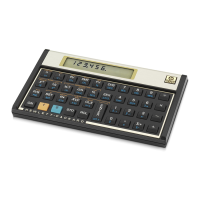52 Section 3: Basic Financial Functions
period” or the “odd days”. (Note that the odd period is always assumed by the
calculator to occur before the first full payment period.) The following two cash
flow diagrams represent transactions including an odd period for payments in
advance (Begin) and for payments in arrears (End).
.
You can calculate i, PV, PMT, and FV for transactions involving an odd period
simply by entering a noninteger n. (A noninteger is a number with at least one
nonzero digit to the right of the decimal point.) This places the calculator in Odd-
Period mode.
10
The integer part of n (the part to the left of the decimal point)
specifies the number of full payment periods, and the fractional part (the part to
the right of the decimal) specifies the length of the odd period as a fraction of a
full period. The odd period, therefore, cannot be greater than one full period.
The fractional part of n can be determined using either the actual number of odd
days or the number of odd days counted on the basis of a 30-day month.
11
The
Ò function can be used to calculate the number of odd days either way. The
fractional part of n is a fraction of a payment period, so the number of odd days
10.
Calculations of i, PMT, and FV are performed using the present value at the end of the odd
period. This is equal to the number in the PV register plus the interest accrued during the odd
period. When calculating PV in Odd-Period mode, the calculator returns a value equal to the
present value at the beginning of the odd period and stores it in the PV register.
After calculating i, PV, PMT, or FV in Odd-Period mode, you should not try to calculate n. If
you do, the calculator will switch out of Odd-Period mode and compute n without taking the
odd period into account. The values in the other financial registers will correspond to the new
n, but the original assumptions for the problem will be changed.
11.
The two methods of counting odd days will yield slightly different answers. If you are
calculating i to determine the annual percentage rate (APR) for an odd-period transaction, the
lower APR will result if the calculation uses the greater number of odd days determined using
the two methods.
odd
period
Begin
End
odd
period

